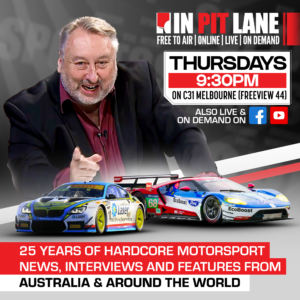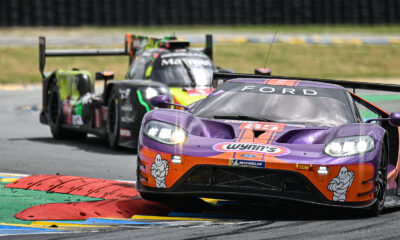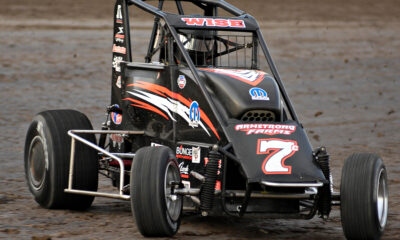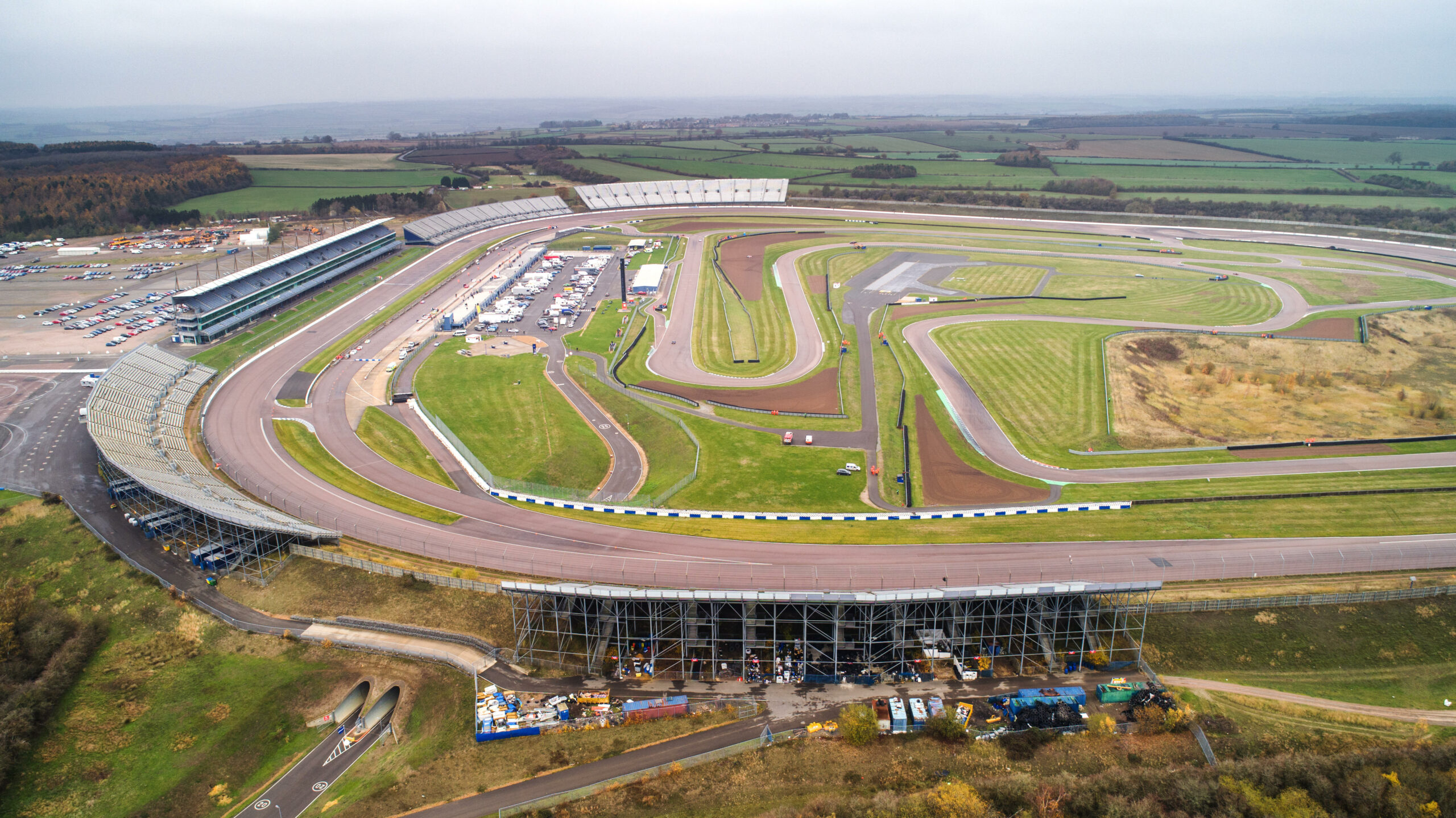
The town of Corby in Northamptonshire was once known for steel production. Local steelworkers crafted their trade for decades until the largest steelworks in the area mostly shuttered. Steel is still produced in the area but nowhere near the ability as in the past. What does this have to do with racing? Everything!
Peter Davies had a passion for motorsports and racing and decided to put some of his entrepreneurial skills, and funds, behind building a track on the grounds of a former quarry and steel production facility. The land was cheap, and Davies had an idea for building a test-track facility. Eventually, the plan grew into constructing a full oval racetrack that would hold sanctioned races.
Over Coming Troubled Beginnings
After gaining control of the land in 1991, Davies only had a short period to raise capital and start construction. If not, the clock would run out on any plans to build what was then called Deene Raceway after the former iron ore quarry site.
Davies traveled to the United States and had taken in several NASCAR and IndyCar circuits and even visited Indianapolis Motor Speedway. Rockingham even has a slightly similar shape as the famed track known as the Brickyard. Four corners with long straights and short shoots.
The facility Davies envisioned would include a squared-shaped oval track with slightly banked turns. There would also be a road course that was laid out in the infield that also utilized almost half of the oval track surface – mostly the area in front of the grandstands. The complex would also be fan friendly with plenty of parking, a large number of restrooms, hospitality areas, and more.
However, bringing on investors proved more difficult than anticipated and other than minor activity, the site remained seemingly dormant for several years. Davies was working behind the scenes. He courted several financial backers from the United States, but they backed out. He also was working towards lining up possible events including F1 and American style stockcar racing.
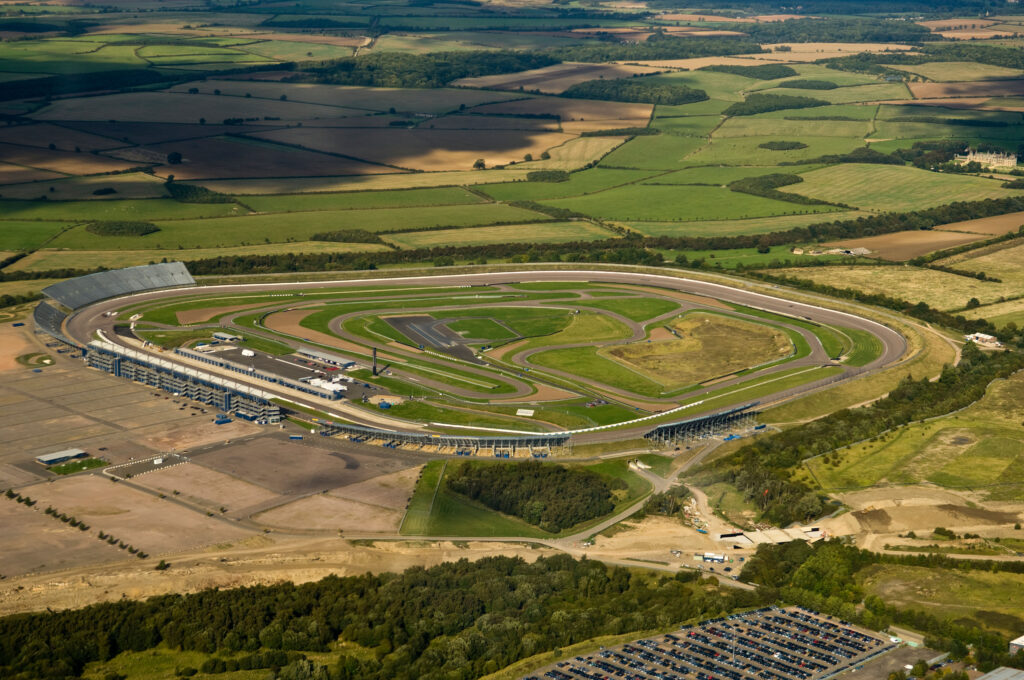
One Step Closer and a Big Investor
Davies moved steadfastly forward to complete his dream. He was still footing much of the early money towards the project, but he knew he could not do it alone. His agreement with the local authorities was that construction on the site had to begin within five years or he would lose his right to build the track.
Davies sold his prized automobile collection to raise funds. And, with time running out on starting construction, Davies and a small crew started moving dirt. Soon they were grading what would become the foundation for the track security office. They leveled it and poured a concrete floor which stopped the five-year clock only a few days before time ran out.
In a 2011 interview with Motor Sport Magazine, Davies explained the rush to build something on the property. “We had to start building on the site because you get five years with planning permission,” Davies said in the interview. “And there was no way we were going to get it (additional time) again.”
The problem of beating the clock on construction was solved but Davies still needed additional financial backing. A mutual friend suggested that he visit Guy Hands who was a successful investor and who would go onto owning EMI. After almost two years of negotiation, Hands was on board and construction could move forward.
The name Deene Raceway was changed to Rockingham Motor Speedway after nearby Rockingham Castle. One of NASCAR’s tracks was also named Rockingham which could only be a positive for promotion, marketing, and wooing additional backers. Heavy construction began in the summer of 1999.
The Sacking of Peter Davies
Gerry Forsythe is a well-known name when it comes to open-wheel racing. He joined the Rockingham endeavor while also bringing in additional funding. He also had string connections to open-wheel racing in the United States. This happened around the same time that full construction was starting.
With a growing number of investors, such as Hands and Forsythe, the project was moving forward. The good news was that the track was set to be finished in record time. And, with the help of Forsythe, the 2001 Cart Series schedule included a date at Rockingham. At the same time, Davies was giving up control of his project.
Suddenly, Davies found himself on the other side of the catch fence – he was sacked! Hands had brought in several new people including a chairman to oversee the final construction projects and get the venue up and running. After a board meeting, Davies was unceremoniously fired along with key team members. They included Christopher Tate who headed up public relations. He had been with Davies for much of the project. Also gone was finance director Robin Smith. Hands put David Grace, five-time British Hillclimb Champion, as the new chief executive.
In an interview with MotorSport Magazine, Davies reflected on his release. “It was deeply offensive and hurtful to be told we were trying to feather our own nests. I hadn’t taken a salary for nine years, my children’s school fees hadn’t been paid for 18 months, I hadn’t paid my mortgage for nearly a year.”
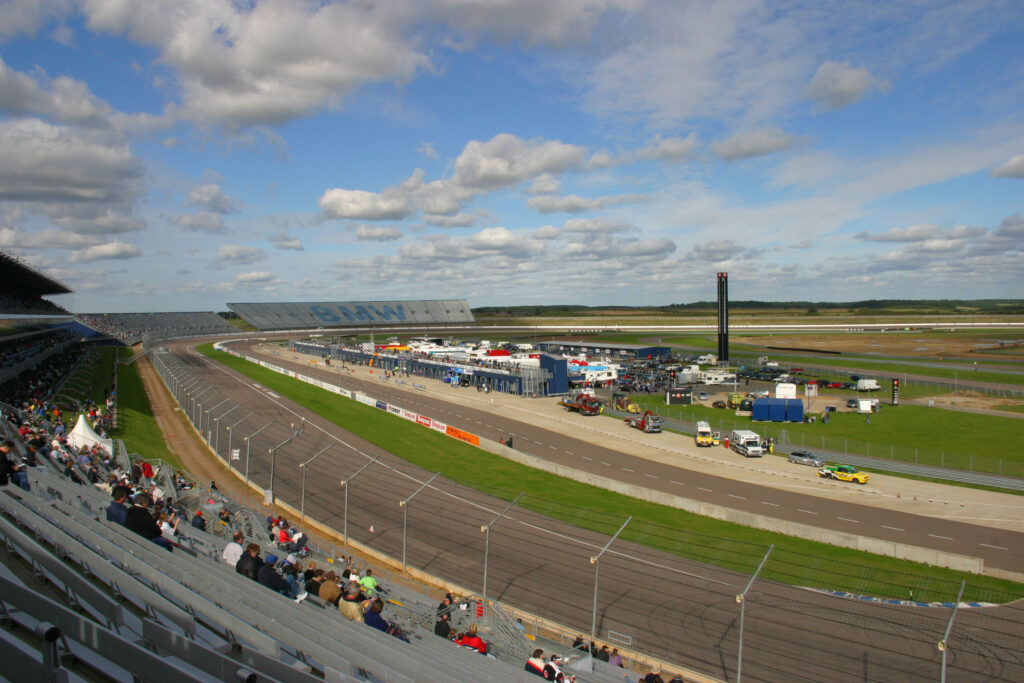
The Queen, Racing, and American-Style Stock Cars!
Finally, after years of planning, fundraising, changes of leadership, and quick construction to finish, the track officially opened on Monday, January 15, 2001. A larger celebration, which included Queen Elizabeth, took place a few months later in May.
The new racing venue could hold over 52,000 fans using the main grandstand, open-air bleachers, enclosed executive suites, food services, and bars. Legend has it that Peter Davies watched the opening event as a spectator.
The track hosted the CART Champ Cars for the Rockingham 500 and the ASCAR Series raced a regular schedule at the Venue for many years. ASCAR Morphed into the Days of Thunder Racing Series and was an attempt to bring NASCAR-styled racing to UK race fans and solidify Rockingham as the hub for multi-series racing ranging from multiple types of cars to motorcycles
Troubles at the Track
The opening of Rockingham Motor Speedway may have seemed to be successful to casual race fans, but the venue had issues from the beginning. The layout of the track was somewhat awkward with the long straights and low-banked turns. The track surface was prone to weeping water following rain. But the main issue was money.
The money negotiated for bringing the Champ Car races was too expensive and was almost impossible to recoup. So, the venue was in the red from the outset. Even with Champ Car, the ASCAR series, British Formula Three Series, motorcycle racing, and the truck racing series, the venue failed to draw enough fans. It regularly fell short of filling the fifty two thousand seats.
The large bleacher sections of seating were not often used which gave the facility an empty look even if a good crowd was on hand. And, there were complaints from some of the neighbors concerning noise. Also, the road course setup was not up to par with similar venues even though it could be configured 13 different ways.
Simply put, the track could not bring in enough money. For example, the first Cart race had over 40,000 fans in attendance while only 25,000 showed up the next season. Cart evolved into the Champ Series and moved to Brands Hatch for the 2003 race season. Guy Hands pulled out, the track saw different ownership, and ASCAR, now being called The Days of Thunder Series, folded.
One the plus side, new ownership came in 2006 and opened up the calendar to a wider range of events. The road course was used more, track days and testing sessions were scheduled, and corporate events took place. The Formula 3 Series was gaining fans as was motorcycle racing. This mixed use approach was turning a profit for the first time in the tracks history.

Racing Ends at Rockingham
Sadly, the good times did not last. The facility saw its last race in 2018 and has since been sold to Constellation Automotive Group. They apparently have no desire to hold sanctioned racing of any kind. Rockingham has now become a massive car park that houses used cars.
The track has been used a few times by CINCH, part of Constellation Automotive Group, to do some YouTube videos but that too seems to have ended. Today, the only news you can find about the speedway comes from YouTube Urban explorers. Several have posted of drone flyover videos of the facility. Sadly, all new footage shows that the track is crammed with parked vehicles leaving no room for any kind of motorsports activity.
Rockingham Motor Speedway only lasted from 2001 to 2018 and it is highly unlikely that it will ever be used for racing again.
To provide feedback on this article, you can contact the editor here or leave a comment below.

Must See
-
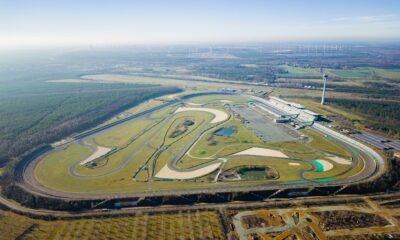

Motorsport Feature Articles
/ 9 months agoLausitzring EuroSpeedway – Germany’s Racing Venue with a Tricky Triangle
When NASCAR fans think about a racetrack that is in the shape of a...
-
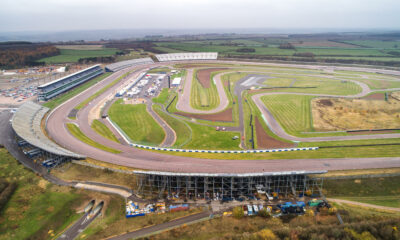

Motorsport Feature Articles
/ 9 months agoThe Brief Racing History of England’s Rockingham Motor Speedway
The town of Corby in Northamptonshire was once known for steel production. Local steelworkers...
-
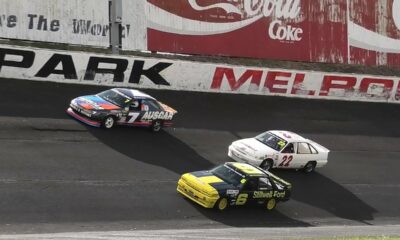

Motorsport Feature Articles
/ 10 months agoThe Unforgettable Legacy of Calder Park Thunderdome: Australia’s Sole NASCAR Superspeedway
In the 1960s, a group of Holden FJ car enthusiasts searched for a place...

Motorsport Feature Articles
Lausitzring EuroSpeedway – Germany’s Racing Venue with a Tricky Triangle

Motorsport News
Juan Pablo Montoya’s Big Return to NASCAR!

Motorsport Feature Articles
The Brief Racing History of England’s Rockingham Motor Speedway

Motorsport Feature Articles
The Unforgettable Legacy of Calder Park Thunderdome: Australia’s Sole NASCAR Superspeedway

Motorsport Feature Articles
The Brief Racing History of England’s Rockingham Motor Speedway

Motorsport Feature Articles
Lausitzring EuroSpeedway – Germany’s Racing Venue with a Tricky Triangle

Driver & Team Profiles
Team Profile: RLR MSport (RLR Motorsport)

Andrea Kimi Antonelli
Driver Profile: Andrea Kimi Antonelli – The Journey to Formula 2 Success

Driver & Team Profiles
Shane Van Gisbergen: 2024 Nascar Season So Far

Motorsport Feature Articles
The Unforgettable Legacy of Calder Park Thunderdome: Australia’s Sole NASCAR Superspeedway

Formula One
F1: 2024 Monaco Grand Prix In Review

